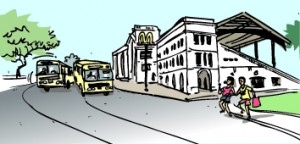Letters
View(s):Unseen side of recent Jaffna incidents
 The unfortunate chain of events that unfolded in Jaffna recently could well be the first of that magnitude reported for quite some time. The mob was asking for the physical custody of several men who were accused of gang raping and killing a young girl while the men were being produced before a magistrate. Perhaps they were in a hurry to give the accused the harshest punishment without waiting for the usually slow legal process. Whether it was some spontaneous reaction from the people or the work of some organised group needs to be established through an independent inquiry.
The unfortunate chain of events that unfolded in Jaffna recently could well be the first of that magnitude reported for quite some time. The mob was asking for the physical custody of several men who were accused of gang raping and killing a young girl while the men were being produced before a magistrate. Perhaps they were in a hurry to give the accused the harshest punishment without waiting for the usually slow legal process. Whether it was some spontaneous reaction from the people or the work of some organised group needs to be established through an independent inquiry.
However some who were bent on making easy political capital out of it were quick to say that these were the signs of terrorism raising its head again and this sort of things would not have happened if they were in power. It is rather unfortunate that such irresponsible statements are being made by our political leaders at a time national reconciliation is of paramount importance.
If there were no such incidents or protests in that part of the country in the recent past it was not because people were very happy and they did not want to protest because they had a perfect administration there during that time. The simple reason was that the military was in tight control, there was no civil administration in the north and they did not have democratic space to engage in any kind of protest.
Protests are a normal thing in any democracy and you see many of them in Colombo almost every other week mostly in front of the Higher Education Ministry or the UGC. In a democracy what needs to be done is not to prevent protests, dissension or expression of different opinions, but accommodating them and noting the causes behind such protests and taking remedial action.
However, this particular wave of incidents exceeded the limits of peaceful protest and developed to be mob violence destroying state property, obstructing police duty and attacking police personnel. Especially since these developments have taken place for the first time after ending terrorism there can be natural fears among the people as to whether there is any return of terrorism. That is why there is a need to have a thorough investigation into the matter to find out whether there was any political or other organized group behind it.
In the event there is no proof to say that there was such organised group behind it, naturally it follows that it was some spontaneous reaction from the people against dastardly and inhuman behaviour by a group of men against a female member of the society. Then the question will arise why such behaviour when there are law enforcement authorities to take appropriate action.
The possible answer is that during the many decades of terrorism there was no democracy in that part of the country. The LTTE which had practically absolute authority over the territory did not have a fair system of trial. They mostly resorted to summary trials or kangaroo courts and harshest punishments were meted out against whoever they thought had perpetrated a crime. What people in the north, the majority of whom may be below the age of 40 would remember is that kind of summary justice and not fair trials for every criminal.
The reaction of the Jaffna youth to the rape and murder in question would have naturally come from what they had seen and experienced in the immediate past and their ignorance as to how police and law courts function in a democracy. It will naturally take a reasonable time for them to experience what democracy is all about and see the value of having a fair system of justice.
Senake Gooneratne
Wattala
Sri Lanka, a land like no other?
 A tourist guide brought two European tourists to the refurbished Race course complex. They were very impressed by the place and made some purchases. They said the setting was pleasing and they were very keen to do a small stroll around the area, and walked towards the main road opposite Royal College.
A tourist guide brought two European tourists to the refurbished Race course complex. They were very impressed by the place and made some purchases. They said the setting was pleasing and they were very keen to do a small stroll around the area, and walked towards the main road opposite Royal College.
Unfortunately at that moment two private buses were racing against each other at full speed with their horns blasting. These buses had the 138 board, hence may have been plying the Maharagama Kottawa route. On seeing this, the tourists got so scared they quickly asked the chauffeur to cancel the rest of the walk and take them back to their hotel.
Now the impression that they will take back home is not anything positive or anything good. In addition they may have glanced through the newspapers and may have seen reports of fraud, corruption bribery and other vices, in addition to the behaviour of our Parliamentarians.
Scared visitor
Via email
Surely the devotees are not deaf!
I was prompted to write after reading the letter from RW, in the Sunday Times, under the heading ‘Stand up and oppose loud broadcasts at places of worship.’
While what Mr. RW says is very true, and needs urgent corrective action by the authorities, especially to ease conditions for the elderly and infants, he focuses on loud broadcasts at night. What I would request is that this protest should also cover loud broadcasts during the day.
Yesterday, at a temple at Ethulkotte, which the President also visited a few days ago, they had a ceremony, which was broadcast over loudspeakers from 8 a.m. to well past 10 p.m. Being a Saturday, lots of adults were at home, and while their usual routine would have been to watch TV or read the newspapers, this Saturday, none of that was possible. The announcer’s, presumably a monk or in turns, a lay preacher’s voice was so grating, even reading was impossible, leave alone listening to TV or radio.
What I fail to understand is that, if the broadcast system is necessary to meet the needs of hundreds of devotees who throng the temple premises, why can’t the volume be adjusted, just enough to cover the temple grounds, and not to cover an area of one kilometre all around the temple. The devotees are not after all deaf.
By comparison, the daytime noise pollution of sweep ticket sellers, chuun paan trishaws, and even heavy vehicle movement, are soothing sounds, in my opinion.
More strength to your mighty pen Mr. RW, and I hope more people will take your exhortation to heart and stand up and oppose loud broadcasts.
JA.
Blood ivory : Why is Sri Lanka so reluctant to conform to international standards on conservation?
The story of how “Blood Ivory” came to Sri Lanka is now well known, and much has been written on it. For those not familiar with the subject, 359 African elephant tusks were discovered hidden in a shipping container. This represents the death of at least 180 African elephants, and probably more, with “collateral” damage.
The Sri Lanka Customs seized this contraband in 2012, but despite a change in Government, and assurances that the new administration would adhere to the law, these gruesome trophies continue to remain in the custody of the Customs Department. Under the Convention on International Trade in Endangered Species (CITES), of which Sri Lanka is a signatory, this ivory should either be destroyed or returned to the country of origin, in this case Kenya.
Kenya was one of the first countries to set an example to the world by destroying its stocks of ivory confiscated from poachers, and has regularly done so since. In recent times, the following countries have also followed suit: UAE, Ethiopia, Malawi, Philippines, USA, Uganda and last, but not least, China. In many of these cases, the Head of State ceremonially lit the flames of their destruction, to show that country’s commitment to preserve the last remaining herds of wild elephants in the world.
Yet, Sri Lanka dawdles, and one wonders why? Speculation is rife that the monetary value of these 359 tusks has excited the interest of those to whom immediate financial benefit is of far more importance than the protection of a wild species, and that of national integrity. It must also be noted that once cut up, it is very difficult, if not impossible to distinguish between African and Asian Ivory. As such, if this ivory is used locally, the tusks of Sri Lankan elephants too may also be illegally included with this stock, and there are precious few of them left in the wild.
In this case, there is no question as to what the right course of action is. The ivory must either be destroyed, or returned to its country of origin. Such profit from mindless massacre should never be given to temples to desecrate the purity of teaching on which they have been founded.
The Wildlife & Nature Protection Society calls on its patron, the President of Sri Lanka, to please look into this matter and do the right thing –destroy these accursed and immoral trophies of blood and ivory for all to see.
Prof. Lakdas D. Fernando
President – Wildlife and Nature Protection Society
Public toilets gone to the wilds
Reading NJ’s letter to the editor in the Sunday Times of April 26, I could not resist writing. During the Sinhala New Year holidays we visited the Wilpattu National Park and as it was raining our tracker stopped at one of the resting places to wait out the rain and have a snack as well.
Similar to the situation at Yala, there were a few jeeps waiting for the same reason. We were happy to see built toilets at this point with a water tank as well. But unfortunately the water was not working and of the two toilets one was marked “do not use” and blocked with sticks. Only one was usable, but in the most despicable state which no words can describe!!
Needless to say we had to use it or go to the jungle which was a flood due to the rain. The men of course went in to the scrub jungle.
G de Lile


